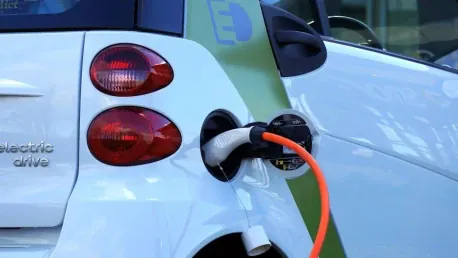The rise of electric vehicles (EVs) signifies a major shift in the automotive industry, marked by explosive growth and necessitating an advanced infrastructure for EV charging stations. This infrastructure is not merely about increasing the number of chargers but creating a networked system where stations effectively communicate with each other. As EV adoption surges, a future-proof charging infrastructure will rely on networked, intelligent systems capable of supporting millions of EVs efficiently and reliably. The subject of analysis revolves around how networked EV charging stations can transform the EV ecosystem, their technological underpinnings, benefits, challenges, and the roles that impending technologies and policies play in this transformation.
Understanding Networked EV Charging Stations
The Backbone of a Reliable Charging Ecosystem
Networked EV charging stations form the backbone of a reliable, scalable, and efficient charging ecosystem. In essence, networked charging points are interconnected through a centralized platform facilitating real-time communication and resource management. This integration enables optimal use of charging stations, providing users with real-time information on station availability, charging speeds, and payment options, similar to a smartphone app. These stations do more than just charge individual vehicles; they are part of an orchestrated system designed to make charging uniform and less chaotic by managing demand effectively. For businesses, offering EV charging services can enhance customer satisfaction, boost employee retention, and generate new revenue streams.
Benefits of Centralized Networks
Centralized networks deliver several key benefits for users and businesses alike. Real-time updates are crucial as users can access up-to-date information on station availability, which reduces the time spent searching for an open charger. Dynamic load balancing plays an essential role in managing the charging load, ensuring that stations are not overwhelmed during peak usage hours. Optimized charging systems prioritize vehicles based on various factors like battery levels and charging speed needs, ensuring reduced wait times and enhanced efficiency. These enhancements mitigate the “range anxiety” that many EV owners experience, making the process of finding and using charging stations smoother and more predictable.
Technological Backbones and Key Features
Real-Time Monitoring and Data Analytics
Real-time monitoring and data analytics are powerful features of a networked charging system. These features allow stakeholders to monitor the health of stations, foresee maintenance needs, detect problems early, and track the overall network performance. Data from these analytics help operators optimize station placements and resource usage, ensuring high service levels and minimal downtime for EV users. Moreover, real-time data analysis often aids in making informed decisions regarding expansions, upgrades, and troubleshooting within the network, significantly boosting operational efficiency.
Smart Charging and Dynamic Load Balancing
Smart charging allows networks to adjust to varying demands. When multiple EVs are charging simultaneously, the system regulates charging speeds to prevent grid overloads and delays. This feature not only optimizes energy distribution but also minimizes operational costs for businesses by scheduling charging during off-peak hours when electricity is cheaper. Furthermore, dynamic load balancing ensures a uniformly distributed electrical load, thereby preventing any localized overloads and ensuring that charging remains rapid and efficient even during peak periods. Implementing smart charging solutions translates into a more reliable and cost-effective overall charging network.
Overcoming Infrastructure Challenges
Connectivity and Reliability Issues
For networked systems to function smoothly, uninterrupted communication between each charging station and the central network is vital. Network outages or connectivity problems can degrade user experience. Infrastructure with redundancy, such as backup systems, ensures operational reliability even when network issues arise. Ensuring constant connectivity is critical, as a single point of failure can severely impact the entire system’s efficiency. Providers invest heavily in creating robust networks that can withstand various operational challenges while maintaining a high level of service quality.
Cost of Infrastructure and Installation
The significant upfront investment needed for installing and connecting charging stations, upgrading electrical systems, and handling increased loads is a primary barrier. Despite the high initial costs, long-term savings and potential revenue, along with government incentives, can offset these expenses, making the investment more palatable. Governments worldwide are recognizing the importance of supporting EV infrastructure and are offering various grants, subsidies, and tax incentives to offset the high initial costs. Additionally, businesses are increasingly able to leverage these financial aids to mitigate the financial impact, making networked EV charging infrastructure more accessible.
Regulatory Challenges and Standardization
Diverse standards for charging connectors, payment methods, and communication protocols create compatibility issues within charging networks. Governments and industry organizations are working to establish universal standards, although it will take time. Businesses need to consider future compatibility to ensure their infrastructure meets evolving standards. The industry is gradually moving towards a more unified approach, facilitating easier integration, and greater interoperability across different network providers and equipment manufacturers. Standardization efforts aim to create a seamless experience for users, reducing confusion and aiding in the widespread adoption of EVs.
Security and Data Privacy
With the proliferation of data over networked systems, robust security measures are imperative. Businesses must ensure that data encompassing user payment information and vehicle data is secured against breaches. Providers prioritizing encryption, routine updates, and secure payment processing are crucial for maintaining consumer trust and regulatory compliance. Implementing stringent cybersecurity protocols is essential to safeguard sensitive information against potential threats. Regular security audits and compliance with international standards further enhance the security posture of networked EV charging infrastructure, fostering user confidence in the system.
Impact on the EV Ecosystem
Boosting Availability and Accessibility
Networked systems ensure optimal placement of charging stations based on demand, addressing charging deserts or areas with inadequate charging facilities. This results in a more evenly distributed and accessible charging infrastructure. Enhanced availability tackles one of the most significant barriers to widespread EV adoption: the fear of not finding a charging station when needed. By ensuring a consistent spread of charging stations across urban, suburban, and rural areas, networked systems promote the adoption of EVs among a broader segment of the population. This in turn drives further investments and improvements in the charging infrastructure.
Enhancing EV Owners’ Charging Experience
A seamless user experience can sway consumers towards adopting EVs fully. Networked stations enhance this experience by providing ease of payment through various methods like credit cards, mobile apps, and subscriptions. Location awareness offers real-time updates on the nearest available chargers and allows users to reserve slots in advance. Optimized charging provides notifications on charging status, easing concerns about overcharging or undercharging. These features collectively contribute to a more user-friendly experience, helping to eliminate the uncertainties associated with using public EV chargers.
Supporting Fleet Electrification and Business Use Cases
Networked stations are critical for businesses with electric fleets. They offer reliable and efficient access to charging, essential for businesses that depend on electric delivery vehicles or company cars. Networked stations enable companies to operate their electric fleets more effectively by ensuring that vehicles are charged and ready for use when needed. Moreover, businesses can leverage public charging stations to offer charging services to customers, which not only generates additional revenue but also enhances green credentials and aligns with corporate sustainability goals.
Role of 5G and IoT
5G Networks and IoT Integration
The integration of 5G and IoT technologies is set to significantly enhance the capabilities of networked EV charging stations. Faster data transfer speeds and lower latency made possible by 5G networks enable real-time station-to-vehicle communication and precise monitoring and maintenance prediction. Indeed, these advancements facilitate seamless user experiences by enabling real-time updates and rapid response to potential issues. Network providers are increasingly exploring innovative solutions to harness the full potential of IoT, leading to smarter and more efficient EV charging networks.
Predictive Analytics and Artificial Intelligence
AI-driven predictive analytics can improve the efficiency of charging networks by forecasting demand spikes, adjusting station distribution, and customizing user experiences based on preferences. Predictive analytics can help in preemptively identifying and addressing potential breakdowns or inefficiencies within the network. This proactive approach not only ensures more reliable service but also potentially extends the lifespan of the equipment used. As AI technology continues to advance, its integration with EV charging networks is expected to drive even greater enhancements in operational efficiency and user satisfaction.
Government Policies and Industry Collaboration
Government Support and Incentives
Government policies and industry collaboration play pivotal roles in the expansion and optimization of EV charging infrastructure. Through tax credits, grants, and subsidies, governments are lowering the initial costs of infrastructure implementation. Urban planning and zoning support are also facilitating the installation of charging stations in key locations. These policies are designed to create an environment conducive to the widespread adoption of EVs by minimizing upfront costs and removing barriers to entry for businesses and consumers alike.
Public-Private Partnerships
Public-private partnerships help in leveraging shared resources and establishing industry standards, ensuring a cohesive and widely accessible network. These collaborations bring together stakeholders from various sectors to work towards common goals, and they can significantly accelerate the deployment and optimization of EV charging infrastructure. The synergies created through such partnerships can lead to innovative solutions that are more comprehensive and effective, addressing many of the challenges faced by individual entities working in isolation.
Conclusion
The surge in electric vehicle (EV) popularity is ushering in a significant transformation in the automotive sector, characterized by rapid growth and an urgent need for a sophisticated EV charging station infrastructure. This infrastructure development goes beyond simply installing more chargers; it entails establishing a networked system where stations can interact and communicate seamlessly. As more people turn to EVs, a sustainable and efficient charging infrastructure will depend on intelligent, interconnected systems designed to support millions of EVs reliably.
The focal point of this transformation is understanding how networked EV charging stations can revolutionize the EV ecosystem. This encompasses examining the technological foundations, advantages, and obstacles of such systems. Additionally, the impact of emerging technologies and policy frameworks on this evolution is crucial. Efficient, networked charging systems will not only simplify the user experience but also enhance energy management and grid stability. As the EV industry continues to grow, developing a robust infrastructure that integrates these advanced networked systems is essential for the widespread adoption of electric mobility.









